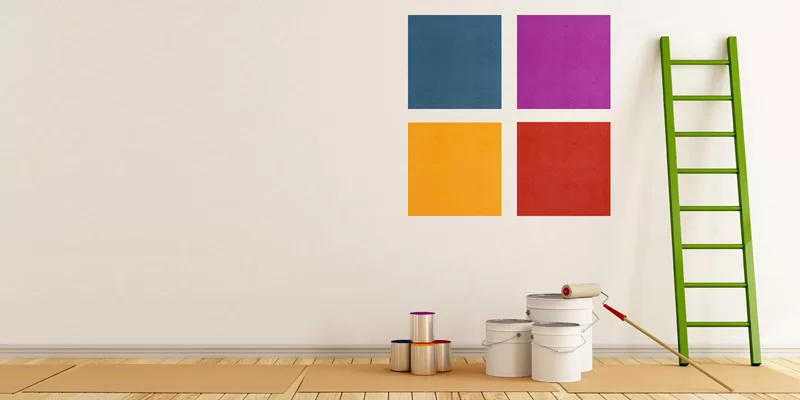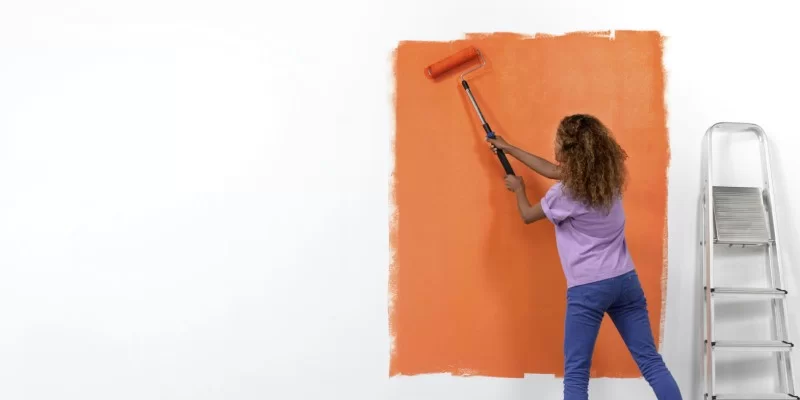Everyone wants their home to be comfortable and beautiful. And the right choice of finishing materials is quite capable of helping to turn housing into a “nest”. And it is especially important to responsibly approach the selection with a limited budget for repairs.
One of the cheapest paints and varnishes on the market are water-based and water-dispersion paints. At a low price, they are distinguished by good hiding power, durability and a variety of colors. But what to choose for the arrangement?
In this material, we will analyze what are the differences between water-based and water-dispersion paint — and which is better to choose.
Water based paint

Water-based paint is an emulsion of various resins in water. It is they who have pigment properties. Microscopic droplets of resins — mineral, silicone or acrylic — after the water base dries, paint the surface.
There are at least several varieties of “water emulsion”. They differ primarily in the additive. Allocate silicate resins, silicone, mineral and acrylic. The difference is manifested both in operational properties and in the field of application.
For example, acrylic water-based paint — the cheapest option — is designed to be placed on wood, brick, concrete and other materials. It covers surfaces with an even, but at the same time vapor-tight layer. In addition, it is not suitable for washing or wet cleaning.
But silicone water-based paint — a more expensive option — provides both vapor permeability and resistance to moisture. That is why it is suitable for application on gypsum and similar “light” plasters.
In general, water-based paint is characterized as follows:
-
Extremely easy to apply and use. Suitable for placement by roller, brush and sprayer. To reduce the viscosity, you can use specialized solvents, as well as white spirit;
-
No smell after drying. And when applied, it is also almost invisible;
-
Fairly fast drying — in 2–6 hours. In this case, full hardness is achieved in 2 days.
It is also worth noting that the “water emulsion” can be initially presented in various colors. Additional tinting is usually not required.
So, let’s sum up.
Advantages
-
Tinting is not required, initially it can be presented in various color options;
-
High environmental friendliness, safety and ease of use;
-
Vapor permeability, temperature stability, wide compatibility with surfaces made of various materials.
Flaws
-
Specific characteristics are determined by the composition of the emulsion and the type of resin;
-
Dilution requires the use of organic solvents rather than water;
-
There are quite expensive options.
Typically, water-based paint is used for interior work. It paints ceilings and walls. It can also be used for furniture, and some options — even for facade work.
Facade water-based paints are best suited for application to wooden surfaces. They are fireproof and vapor permeable. However, they do not create a durable coating (as acrylics do), so it is recommended to impregnate the wood with protective agents before application to prevent mold and pests.
Water dispersion paint

Water dispersion paints are an aqueous solution of various pigments. In addition, they include vinyl acetate and acrylic polymers. It is they who “bind” the water, which serves as the basis of the material, and the coloring elements.
Water dispersion paints are characterized by excellent adhesion. That is why they can be applied to almost any surface. Even previously painted materials are easily and permanently coated with them. However, the hiding power of water-dispersion paints is rather average, as a result of which consumption increases.
An important feature of water-dispersion paints is durability. So, their operational period is up to 20 years with proper preparation of the base. This is due not only to polymers in the base, but also to resistance to ultraviolet radiation and direct sunlight. Paints retain not only the quality and degree of coverage, but also the shade — they do not “burn out” and do not “turn yellow”.
The good vapor permeability of water-dispersion paints makes them suitable for application on drywall, as well as gypsum plasters and other “light” materials. Moisture in the thickness of the base does not linger, but evaporates naturally, providing durability and protection against harmful biological factors (the appearance of fungus, mold, bacterial destruction).
Water-dispersion paints do not contain organic volatile solvents. That is why these materials are suitable both for children’s rooms and for use in healthcare and catering establishments. Some paints also contain wash-resistant polymers, making them resistant to daily wet cleaning, including disinfectants.
In general, water-dispersion paints are characterized as follows:
-
Suitable for roller and spray application. The liquid texture makes it not very comfortable to use with a brush. Can be diluted — while ordinary water acts as a solvent;
-
There is no smell either when dry or when applied;
-
Fastest drying. When applied layer-by-layer, the layer dries out in 30 minutes, sufficient strength occurs after 2 hours, and full strength after about a day, and the specific value depends on the temperature and humidity conditions of the room.
However, waterborne paints are only available in white. So tinting is required. Fortunately, large stores offer their services in the selection of shades and kneading.
So, let’s sum up.
Advantages
-
Resistant to sunlight and ultraviolet radiation;
-
Possesses air and vapor permeable properties;
-
There are options that can be used in children’s rooms, healthcare and catering facilities, including those that support daily wet cleaning.
Flaws
-
Average hiding power, which leads to increased consumption of material;
-
High cost in comparison with water-based paint;
-
It is required to properly prepare the base;
-
Water-based paints themselves exist in three versions — polyvinyl acetate, latex and acrylic.
Polyvinyl acetate (PVA) have a low price. But at the same time, they do not support wet cleaning, are not suitable for bathrooms and kitchens, and are also soiled.
Latex and acrylic support wet cleaning, can be used in bathrooms and kitchens. But at the same time they are expensive.
Which is better — water-based or water-based paint?

So, water-based emulsion is suitable for any work, including facade work, but it does not differ in particular durability. In some cases, water dispersion can even be washed, but the price is higher, and the surface needs to be prepared.
But the difference between the two finishing materials is not limited to this. Let’s compare them.
|
|
|
|
|
|
silicate, silicone, mineral, acrylic
|
Latex, polyvinyl acetate, acrylic
|
|
|
Not too much
|
Yes
|
|
|
Not too much
|
Yes
|
|
|
In most cases, no
|
In most cases yes
|
|
|
White spirit, other organic materials
|
Water
|
|
|
Usually not required
|
Mandatory
|
|
|
High
|
High
|
|
|
Malaya
|
High
|
So. If you want to achieve maximum security of the premises, to carry out work in the bathroom or kitchen, then it is better not to save money and purchase a latex or acrylic “water dispersion”. And if the budget is very limited, including not allowing for normal preparation of the base, then you can limit yourself to “water emulsion”.

Добавить комментарий
Для отправки комментария вам необходимо авторизоваться.